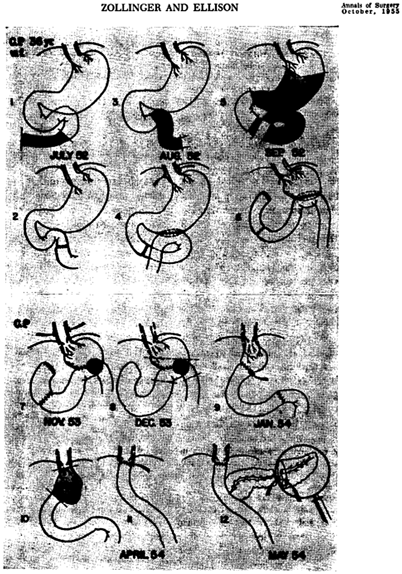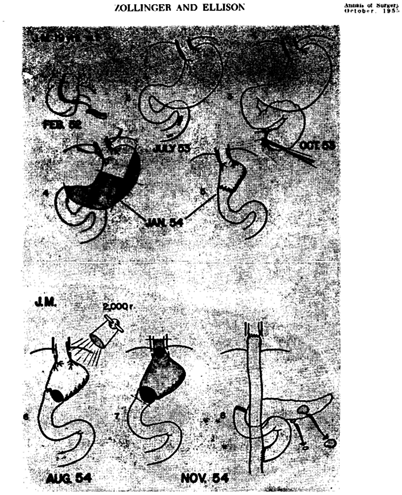Robert M. Zollinger. Photograph taken for cover of Modern Medicine, May 25, 1964
Surgeons and physicians will always associate Dr. Zollinger with gastrinoma , the “Zollinger–Ellison syndrome,” which he and Dr. Ellison described in 1955 [1]. He is also remembered as one of the giants of twentieth-century American surgery.
Robert Milton Zollinger was born on September 4, 1903, in Millersport, OH, USA [2]. He grew up on his family’s farm. As a boy, he had a business delivering milk and vegetables from his family farm to the neighbors. He was athletic and lettered in basketball during high school. He initially wanted to attend West Point, but when he decided to become a doctor, he went to Ohio State University, where he received a BA in 1925 and MD in 1927. He was a competitive young medical student: “I got a C in surgery and I said then I was coming back as a professor of surgery” [3].
Dr. Zollinger was offered an internship at Peter Bent Brigham Hospital by Harvey Cushing. Dr. Cushing sent him to Western Reserve in Cleveland to work with Cushing’s pupil Elliot Carr Cutler (1888–1947) for 6 months before starting the internship at the Brigham in 1928.
After his internship, Zollinger returned to work with Cutler in 1929, as a surgery resident at Lakeside Hospital and Western Reserve University in Cleveland. When Cutler took over from Cushing as the Mosley Professor at the Brigham in 1932, Zollinger went with him as his chief resident. Cutler and Zollinger subsequently published the first of nine editions of the Atlas of Surgical Operations. In 1939, Zollinger was appointed assistant professor at Harvard at Peter Bent Brigham Hospital.
Dr. Zollinger joined the army before the start of World War II (WWII) in 1941 and served until 1945. He joined the Harvard Unit as a major in the Medical Corp of the US Army in Ireland and was the assistant chief of the Surgical Service. Because of his farm experience and love of roses, he planted a garden and cultivated roses and was appointed the post, beautification officer. Dr. Zollinger was promoted to colonel and was senior consultant in surgery to the European Theater of Operation, and commander of the 5th General Hospital in France. He was awarded the Legion of Merit by the US Army for the development of mobile surgical teams (with Colonel Dr. Michael DeBakey and others). He earned Battle Stars for Normandy, Northern France, and Rhineland, and the European–African–Middle Eastern Service Medal.
Dr. Zollinger returned to Harvard after WWII. However, soon after in 1946, he returned to his alma mater Ohio State University as professor of surgery. Within a year, he became chairman of the Department of Surgery. He built and grew the Department of Surgery at Ohio State University until he retired as professor emeritus in 1974. Dr. Zollinger continued his surgical practice until January of 1983, retiring at age 79 [3, 4]. He died from pancreatic cancer, on June 12, 1992, in Columbus, OH, USA [5].
The Paper
Dr. Zollinger recruited Dr. Edwin Homer Ellison as soon as he arrived at Ohio State in 1946. Dr. Ellison was a medical student at Ohio State, studied biochemistry, and had just finished his surgical residency at Ohio State in 1946 [6]. They became close friends and collaborators over the next decades. In 1967, Dr. Ellison became professor and chairman of surgery at the Marquette School of Medicine in Milwaukee.
Zollinger and Ellison presented the paper “Primary peptic ulceration of the jejunum associated with islet cell tumors of the pancreas” before the American Surgical Association in Philadelphia on April 29, 1955 [1]. They described two patients in detail. One was a 36-year-old woman, a patient of Ellison, who had recurrent jejunal ulceration that required several resections and finally had a total gastrectomy, esophago-duodenotomy for bleeding, and eventually died of anastomotic perforation (Fig. 1 ). Autopsy showed a well-encapsulated 1-cm nodule in the tail of the pancreas with other smaller surrounding nodules. The other patient was a 19-year-old woman, a patient of Zollinger. She had two episodes of jejunal perforation and uncontrollable ulcers with hypersecretion of gastric acid. She had already undergone a truncal vagotomy, proximal gastrectomy, and irradiation of gastric remnant. Dr. Zollinger performed a total gastrectomy, pancreas resection, and node dissection (Fig. 2 ). Following the suggestion of Dr. Hilger Jenkins of Chicago to look for an insulinoma, Dr. Zollinger was initially disappointed after not finding any obvious tumor in the pancreas during the operation. However, subsequent final pathology exam showed a small pancreatic tumor with metastatic lymph nodes .




Stay updated, free articles. Join our Telegram channel

Full access? Get Clinical Tree









